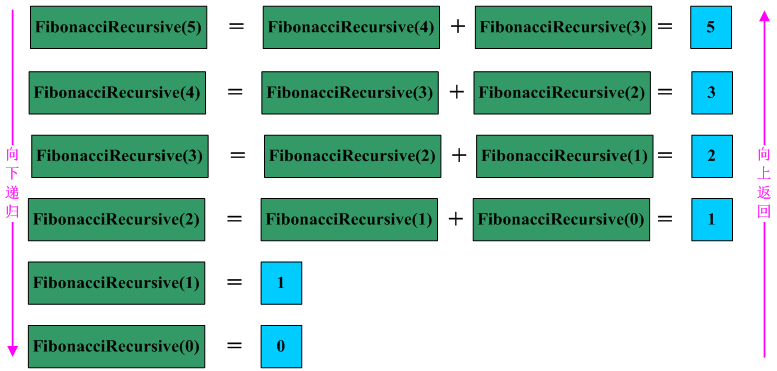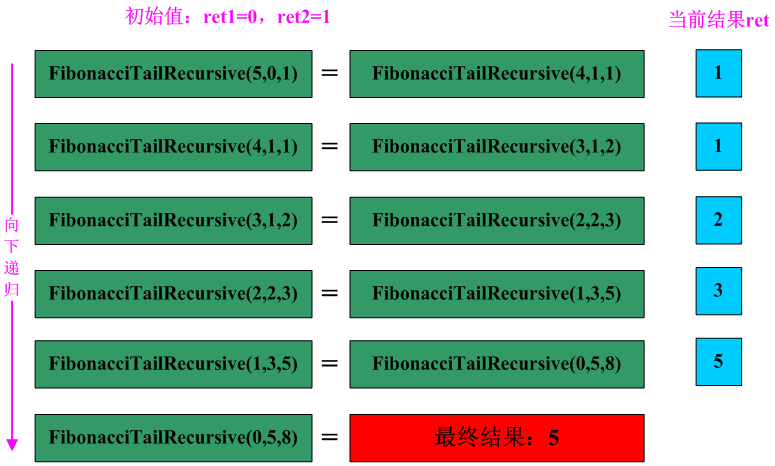递归与尾递归总结
前言:今天上网看帖子的时候,看到关于尾递归的应用(http://bbs.csdn.net/topics/390215312),大脑中感觉这个词好像在哪里见过,但是又想不起来具体是怎么回事。如是乎,在网上搜了一下,顿时豁然开朗,知道尾递归是怎么回事了。下面就递归与尾递归进行总结,以方便日后在工作中使用。
1、递归
关于递归的概念,我们都不陌生。简单的来说递归就是一个函数直接或间接地调用自身,是为直接或间接递归。一般来说,递归需要有边界条件、递归前进段和递归返回段。当边界条件不满足时,递归前进;当边界条件满足时,递归返回。用递归需要注意以下两点:(1) 递归就是在过程或函数里调用自身。(2) 在使用递归策略时,必须有一个明确的递归结束条件,称为递归出口。
1 int FibonacciRecursive(int n)
2 {
3 if( n < 2)
4 return n;
5 return (FibonacciRecursive(n-1)+FibonacciRecursive(n-2));
6 }
递归写的代码非常容易懂,完全是根据函数的条件进行选择计算机步骤。例如现在要计算n=5时的值,递归调用过程如下图所示:

2、尾递归
顾名思义,尾递归就是从最后开始计算, 每递归一次就算出相应的结果, 也就是说, 函数调用出现在调用者函数的尾部, 因为是尾部, 所以根本没有必要去保存任何局部变量. 直接让被调用的函数返回时越过调用者, 返回到调用者的调用者去。尾递归就是把当前的运算结果(或路径)放在参数里传给下层函数,深层函数所面对的不是越来越简单的问题,而是越来越复杂的问题,因为参数里带有前面若干步的运算路径。
尾递归是极其重要的,不用尾递归,函数的堆栈耗用难以估量,需要保存很多中间函数的堆栈。比如f(n, sum) = f(n-1) + value(n) + sum; 会保存n个函数调用堆栈,而使用尾递归f(n, sum) = f(n-1, sum+value(n)); 这样则只保留后一个函数堆栈即可,之前的可优化删去。
采用尾递归实现Fibonacci函数,程序如下所示:
1 int FibonacciTailRecursive(int n,int ret1,int ret2)
2 {
3 if(n==0)
4 return ret1;
5 return FibonacciTailRecursive(n-1,ret2,ret1+ret2);
6 }
例如现在要计算n=5时的值,尾递归调用过程如下图所示:
从图可以看出,为递归不需要向上返回了,但是需要引入而外的两个空间来保持当前的结果。
为了更好的理解尾递归的应用,写个程序进行练习。采用直接递归和尾递归的方法求解单链表的长度,C语言实现程序如下所示:
1 #include <stdio.h> 2 #include <stdlib.h> 3 4 typedef struct node 5 { 6 int data; 7 struct node* next; 8 }node,*linklist; 9 10 void InitLinklist(linklist* head) 11 { 12 if(*head != NULL) 13 free(*head); 14 *head = (node*)malloc(sizeof(node)); 15 (*head)->next = NULL; 16 } 17 18 void InsertNode(linklist* head,int d) 19 { 20 node* newNode = (node*)malloc(sizeof(node)); 21 newNode->data = d; 22 newNode->next = (*head)->next; 23 (*head)->next = newNode; 24 } 25 26 //直接递归求链表的长度 27 int GetLengthRecursive(linklist head) 28 { 29 if(head->next == NULL) 30 return 0; 31 return (GetLengthRecursive(head->next) + 1); 32 } 33 //采用尾递归求链表的长度,借助变量acc保存当前链表的长度,不断的累加 34 int GetLengthTailRecursive(linklist head,int *acc) 35 { 36 if(head->next == NULL) 37 return *acc; 38 *acc = *acc+1; 39 return GetLengthTailRecursive(head->next,acc); 40 } 41 42 void PrintLinklist(linklist head) 43 { 44 node* pnode = head->next; 45 while(pnode) 46 { 47 printf("%d->",pnode->data); 48 pnode = pnode->next; 49 } 50 printf("->NULL\n"); 51 } 52 53 int main() 54 { 55 linklist head = NULL; 56 int len = 0; 57 InitLinklist(&head); 58 InsertNode(&head,10); 59 InsertNode(&head,21); 60 InsertNode(&head,14); 61 InsertNode(&head,19); 62 InsertNode(&head,132); 63 InsertNode(&head,192); 64 PrintLinklist(head); 65 printf("The length of linklist is: %d\n",GetLengthRecursive(head)); 66 GetLengthTailRecursive(head,&len); 67 printf("The length of linklist is: %d\n",len); 68 system("pause"); 69 }
程序测试结果如下图所示:

参考:http://www.cnblogs.com/JeffreyZhao/archive/2009/03/26/tail-recursion-and-continuation.html



